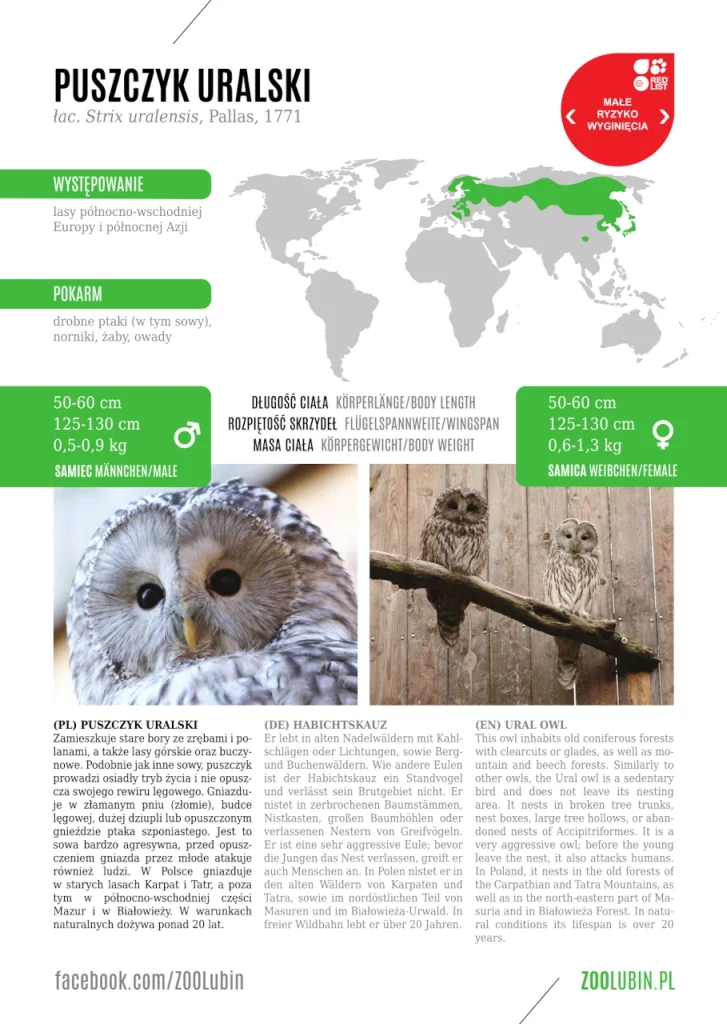
POBIERZ ETYKIETĘ GATUNKOWĄ – PLIK PDF (rozmiar 2304 KB)
Puszczyk uralski (PL)
łac. Strix uralensis, Pallas, 1771
Zamieszkuje stare bory ze zrębami i polanami, a także lasy górskie oraz buczyny. Podobnie jak inne sowy, puszczyk prowadzi osiadły tryb życia i nie opuszcza swojego rewiru lęgowego. Gniazduje w złamanym pniu (złomie), budce lęgowej, dużej dziupli lub w opuszczonym gnieździe ptaka szponiastego. Jest to sowa bardzo agresywna; przed opuszczeniem gniazda przez młode atakuje również ludzi. W Polsce gniazduje w starych lasach Karpat i Tatr, a poza tym w północno-wschodniej części Mazur i w Białowieży. W warunkach naturalnych dożywa ponad 20 lat.
Występowanie: lasy północno-wschodniej Europy i północnej Azji
samiec / samica
Długość ciała: 50-60 cm
Rozpiętość skrzydeł: 123-130 cm
Masa ciała: 0,5–0,9 kg / 0,6–1,3 kg
Uralkauz (DE)
łac. Strix uralensis, Pallas, 1771
Er lebt in alten Nadelwäldern mit Kahlschlägen oder Lichtungen, sowie Berg- und Buchenwäldern. Wie andere Eulen ist der Habichtskauz ein Standvogel und verlässt sein Brutgebiet nicht. Er nistet in zerbrochenen Baumstämmen, Nistkasten, großen Baumhöhlen oder verlassenen Nestern der Greifvögeln. Es ist eine sehr aggressive Eule; bevor die Jungen das Nest verlassen, greift er auch Menschen an. In Polen nistet er in den alten Wäldern der Karpaten und Tatra sowie im nordöstlichen Teil von Masuren und im Białowieża-Urwald. In freier Wildbahn erreicht diese Gattung ein Alter von über 20 Jahren.
Vorkommen: Wälder Nordosteuropas und Nordasiens
Männchen / Weibchen
Körperlänge: 50-60 cm
Flügelspannweite: 123-130 cm
Körpermasse: 0,5–0,9 kg / 0,6–1,3 kg
Ural owl (EN)
łac. Strix uralensis, Pallas, 1771
The ural owl inhabits old coniferous forests with clearfelling patches or glades, as well as mountain and beech forests. Similarly to other owls, it is a sedentary bird and does not leave its nesting area. It inhabits broken tree trunks, nest boxes, large tree hollows, or abandoned nests of Accipitriformes. It is a very aggressive bird; before the young leave the nest, it attacks even humans. In Poland, it lives in the old forests of the Carpathian and Tatra Mountains, as well as in the north-eastern part of Masuria and in Białowieża Forest. In natural conditions its lifespan exceeds 20 years.
Distribution: forests of Northeastern Europe and Northern Asia
male / female
body length: 50-60 cm
wingspan: 123-130 cm
body mass: 0,5–0,9 kg / 0,6–1,3 kg
